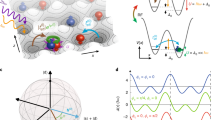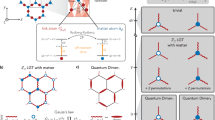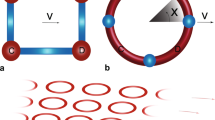Abstract
Quantum simulation has the potential to investigate gauge theories in strongly interacting regimes, which are currently inaccessible through conventional numerical techniques. Here, we take a first step in this direction by implementing a Floquet-based method for studying \({\Bbb Z}_2\) lattice gauge theories using two-component ultracold atoms in a double-well potential. For resonant periodic driving at the on-site interaction strength and an appropriate choice of the modulation parameters, the effective Floquet Hamiltonian exhibits \({\Bbb Z}_2\) symmetry. We study the dynamics of the system for different initial states and critically contrast the observed evolution with a theoretical analysis of the full time-dependent Hamiltonian of the periodically driven lattice model. We reveal challenges that arise due to symmetry-breaking terms and outline potential pathways to overcome these limitations. Our results provide important insights for future studies of lattice gauge theories based on Floquet techniques.
This is a preview of subscription content, access via your institution
Access options
Access Nature and 54 other Nature Portfolio journals
Get Nature+, our best-value online-access subscription
$29.99 / 30 days
cancel any time
Subscribe to this journal
Receive 12 print issues and online access
$209.00 per year
only $17.42 per issue
Buy this article
- Purchase on Springer Link
- Instant access to full article PDF
Prices may be subject to local taxes which are calculated during checkout





Similar content being viewed by others
Data availability
The data that support the plots within this paper and other findings of this study are available from the corresponding author on reasonable request.
Code availability
The code that supports the plots within this paper are available from the corresponding author on reasonable request.
References
Wilson, K. G. Confinement of quarks. Phys. Rev. D 10, 2445–2459 (1974).
Kogut, J. B. An introduction to lattice gauge theory and spin systems. Rev. Mod. Phys. 51, 659–713 (1979).
Wen, X.-G. Quantum Field Theory of Many-Body Systems (Oxford University Press, 2004).
Levin, M. & Wen, X.-G. Colloquium: photons and electrons as emergent phenomena. Rev. Mod. Phys. 77, 871–879 (2005).
Lee, P. A., Nagaosa, N. & Wen, X.-G. Doping a Mott insulator: physics of high temperature superconductivity. Rev. Mod. Phys. 78, 17–85 (2006).
Ichinose, I. & Matsui, T. Lattice gauge theory for condensed matter physics: ferromagnetic superconductivity as its example. Mod. Phys. Lett. B 28, 1430012 (2014).
Aoki, S. et al. Review of lattice results concerning low-energy particle physics. Eur. Phys. J. C 77, 112 (2017).
Troyer, M. & Wiese, U.-J. Computational complexity and fundamental limitations to fermionic quantum Monte Carlo simulations. Phys. Rev. Lett. 94, 170201 (2005).
Alford, M. G., Schmitt, A., Rajagopal, K. & Schäfer, T. Color superconductivity in dense quark matter. Rev. Mod. Phys. 80, 1455–1515 (2008).
Buyens, B., Verstraete, F. & Acoleyen, K. V. Hamiltonian simulation of the Schwinger model at finite temperature. Phys. Rev. D 94, 085018 (2016).
Bañuls, M. C. et al. Towards overcoming the Monte Carlo sign problem with tensor networks. EPJ Web Conf. 137, 04001 (2017).
Silvi, P., Rico, E., Dalmonte, M., Tschirsich, F. & Montangero, S. Finite-density phase diagram of a (1 + 1) − d non-abelian lattice gauge theory with tensor networks. Quantum 1, 9 (2017).
Gazit, S., Randeria, M. & Vishwanath, A. Emergent Dirac fermions and broken symmetries in confined and deconfined phases of Z 2 gauge theories. Nat. Phys. 13, 484–490 (2017).
Weimer, H., Müller, M., Lesanovsky, I., Zoller, P. & Büchler, H. P. A Rydberg quantum simulator. Nat. Phys. 6, 382–388 (2010).
Blatt, R. & Roos, C. F. Quantum simulations with trapped ions. Nat. Phys. 8, 277–284 (2012).
Gross, C. & Bloch, I. Quantum simulations with ultracold atoms in optical lattices. Science 357, 995–1001 (2017).
Romero, G., Solano, E. & Lamata, L. in Quantum Simulations with Photons and Polaritons (ed. Angelakis, D.) 153–180 (Springer, 2017).
Tagliacozzo, L., Celi, A., Zamora, A. & Lewenstein, M. Optical abelian lattice gauge theories. Ann. Phys. 330, 160–191 (2013).
Wiese, U.-J. Ultracold quantum gases and lattice systems: quantum simulation of lattice gauge theories. Ann. Phys. 525, 777–796 (2013).
Zohar, E., Cirac, J. I. & Reznik, B. Quantum simulations of lattice gauge theories using ultracold atoms in optical lattices. Rep. Prog. Phys. 79, 014401 (2015).
Dalmonte, M. & Montangero, S. Lattice gauge theory simulations in the quantum information era. Contemp. Phys. 57, 388–412 (2016).
Notarnicola, S. et al. Discrete Abelian gauge theories for quantum simulations of QED. J. Phys. A 48, 30FT01 (2015).
Kasper, V., Hebenstreit, F., Jendrzejewski, F., Oberthaler, M. K. & Berges, J. Implementing quantum electrodynamics with ultracold atomic systems. New J. Phys. 19, 023030 (2017).
Kuno, Y., Sakane, S., Kasamatsu, K., Ichinose, I. & Matsui, T. Quantum simulation of (1 + 1)-dimensional U(1) gauge-Higgs model on a lattice by cold Bose gases. Phys. Rev. D 95, 094507 (2017).
Zhang, J. et al. Quantum simulation of the universal features of the polyakov loop. Phys. Rev. Lett. 121, 223201 (2018).
Aidelsburger, M., Nascimbène, S. & Goldman, N. Artificial gauge fields in materials and engineered systems. C. R. Phys. 19, 394–432 (2018).
Clark, L. W. et al. Observation of density-dependent gauge fields in a bose-einstein condensate based on micromotion control in a shaken two-dimensional lattice. Phys. Rev. Lett. 121, 030402 (2018).
Anderlini, M. et al. Controlled exchange interaction between pairs of neutral atoms in an optical lattice. Nature 448, 452–456 (2007).
Trotzky, S. et al. Time-resolved observation and control of superexchange interactions with ultracold atoms in optical lattices. Science 319, 295–299 (2008).
Dai, H.-N. et al. Four-body ring-exchange interactions and anyonic statistics within a minimal toric-code Hamiltonian. Nat. Phys. 13, 1195–1200 (2017).
Klco, N. et al. Quantum-classical computation of schwinger model dynamics using quantum computers. Phys. Rev. A 98, 032331 (2018).
Martinez, E. A. et al. Real-time dynamics of lattice gauge theories with a few-qubit quantum computer. Nature 534, 516–519 (2016).
Barbiero, L. et al. Coupling ultracold matter to dynamical gauge fields in optical lattices: from flux-attachment to ℤ2 lattice gauge theories. Preprint at https://arxiv.org/abs/1810.02777 (2018).
Zohar, E., Farace, A., Reznik, B. & Cirac, J. I. Digital quantum simulation of ℤ2 lattice gauge theories with dynamical fermionic matter. Phys. Rev. Lett. 118, 070501 (2017).
Horn, D., Weinstein, M. & Yankielowicz, S. Hamiltonian approach to Z(N) lattice gauge theories. Phys. Rev. D 19, 3715–3731 (1979).
Ju, H. & Balents, L. Finite-size effects in the Z 2 spin liquid on the kagome lattice. Phys. Rev. B 87, 195109 (2013).
González-Cuadra, D., Dauphin, A., Grzybowski, P. R., Lewenstein, M. & Bermudez, A. Symmetry-breaking topological insulator in the ℤ2 Bose-Hubbar dmodel. Phys. Rev. B 99, 045139 (2019).
Kitaev, A. Y. Fault-tolerant quantum computation by anyons. Ann. Phys. 303, 2–30 (2003).
Keilmann, T., Lanzmich, S., McCulloch, I. & Roncaglia, M. Statistically induced phase transitions and anyons in 1d optical lattices. Nat. Commun. 2, 361 (2011).
Greschner, S. & Santos, L. Anyon hubbard model in one-dimensional optical lattices. Phys. Rev. Lett. 115, 053002 (2015).
Bermudez, A. & Porras, D. Interaction-dependent photon-assisted tunneling in optical lattices: a quantum simulator of strongly correlated electrons and dynamical gauge fields. New. J. Phys. 17, 103021 (2015).
Sträter, C., Srivastava, S. C. L. & Eckardt, A. Floquet realization and signatures of one-dimensional anyons in an optical lattice. Phys. Rev. Lett. 117, 205303 (2016).
Goldman, N., Dalibard, J., Aidelsburger, M. & Cooper, N. R. Periodically driven quantum matter: the case of resonant modulations. Phys. Rev. A 91, 033632 (2015).
Goldman, N. & Dalibard, J. Periodically driven quantum systems: effective hamiltonians and engineered gauge fields. Phys. Rev. X 4, 031027 (2014).
Bukov, M., D’Alessio, L. & Polkovnikov, A. Universal high-frequency behavior of periodically driven systems: from dynamical stabilization to Floquet engineering. Adv. Phys. 64, 139–226 (2015).
Eckardt, A. Colloquium: atomic quantum gases in periodically driven optical lattices. Rev. Mod. Phys. 89, 011004 (2017).
Ma, R. et al. Photon-assisted tunneling in a biased strongly correlated bose gas. Phys. Rev. Lett. 107, 095301 (2011).
Chen, Y.-A. et al. Controlling correlated tunneling and superexchange interactions with ac-driven optical lattices. Phys. Rev. Lett. 107, 210405 (2011).
Meinert, F., Mark, M. J., Lauber, K., Daley, A. J. & Nägerl, H.-C. Floquet engineering of correlated tunneling in the bose-hubbard model with ultracold atoms. Phys. Rev. Lett. 116, 205301 (2016).
Görg, F. et al. Realization of density-dependent Peierls phases to engineer quantized gauge fields coupled to ultracold matter. Nat. Phys. https://doi.org/10.1038/s41567-019-0615-4 (2019).
Keay, B. J. et al. Dynamic localization, absolute negative conductance, and stimulated, multiphoton emission in sequential resonant tunneling semiconductor superlattices. Phys. Rev. Lett. 75, 4102–4105 (1995).
Lignier, H. et al. Dynamical control of matter-wave tunneling in periodic potentials. Phys. Rev. Lett. 99, 220403 (2007).
Sias, C. et al. Observation of photon-assisted tunneling in optical lattices. Phys. Rev. Lett. 100, 63 (2008).
Mukherjee, S. et al. Modulation-assisted tunneling in laser-fabricated photonic Wannier–Stark ladders. New J. Phys. 17, 115002 (2015).
Scarola, V. W. & Sarma, S. D. Quantum phases of the extended bose-hubbard hamiltonian: possibility of a supersolid state of cold atoms in optical lattices. Phys. Rev. Lett. 95, 033003 (2005).
Banerjee, D. et al. Atomic quantum simulation of U(N) and SU(N) non-Abelian lattice gauge theories. Phys. Rev. Lett. 110, 125303 (2013).
Kühn, S., Cirac, J. I. & Bañuls, M.-C. Quantum simulation of the Schwinger model: a study of feasibility. Phys. Rev. A 90, 042305 (2014).
Acknowledgements
We acknowledge insightful discussions with M. Dalmonte, A. Trombettoni and M. Lohse. This work was supported by the Deutsche Forschungsgemeinschaft (DFG, German Research Foundation) under project no. 277974659 via Research Unit FOR 2414 and under project no. 282603579 via DIP, the European Commission (UQUAM grant no. 5319278) and the Nanosystems Initiative Munich (NIM, grant no. EXC4). The work was further funded by the Deutsche Forschungsgemeinschaft (DFG, German Research Foundation) under Germany’s Excellence Strategy—EXC-2111—390814868. Work in Brussels was supported by the FRS-FNRS (Belgium) and the ERC Starting Grant TopoCold. F.G. additionally acknowledges support by the Gordon and Betty Moore Foundation under the EPIQS programme and from the Technical University of Munich—Institute for Advanced Study, funded by the German Excellence Initiative and the European Union FP7 under grant agreement 291763, from the DFG grant no. KN 1254/1-1, and DFG TRR80 (Project F8). F.G. and E.D. acknowledge funding from Harvard-MIT CUA, AFOSR-MURI Quantum Phases of Matter (grant no. FA9550-14-1-0035), AFOSR-MURI: Photonic Quantum Matter (award no. FA95501610323) and DARPA DRINQS programme (award no. D18AC00014).
Author information
Authors and Affiliations
Contributions
C.S., F.G., N.G. and M.A. planned the experiment and performed theoretical calculations. C.S. and M.B. performed the experiment and analysed the data with M.A. All authors discussed the results and contributed to the writing of the paper.
Corresponding author
Ethics declarations
Competing interests
The authors declare no competing interests.
Additional information
Publisher’s note Springer Nature remains neutral with regard to jurisdictional claims in published maps and institutional affiliations.
Supplementary information
Supplementary Information
Supplementary Figs. 1–13, text and references.
Rights and permissions
About this article
Cite this article
Schweizer, C., Grusdt, F., Berngruber, M. et al. Floquet approach to ℤ2 lattice gauge theories with ultracold atoms in optical lattices. Nat. Phys. 15, 1168–1173 (2019). https://doi.org/10.1038/s41567-019-0649-7
Received:
Accepted:
Published:
Issue Date:
DOI: https://doi.org/10.1038/s41567-019-0649-7
This article is cited by
-
Dynamical localization transition in the non-Hermitian lattice gauge theory
Communications Physics (2024)
-
Quantum simulation of fundamental particles and forces
Nature Reviews Physics (2023)
-
Three-dimensional non-Abelian quantum holonomy
Nature Physics (2023)
-
Realistic scheme for quantum simulation of \({{\mathbb{Z}}}_{2}\) lattice gauge theories with dynamical matter in (2 + 1)D
Communications Physics (2023)
-
Projective spacetime symmetry of spacetime crystals
Communications Physics (2023)



